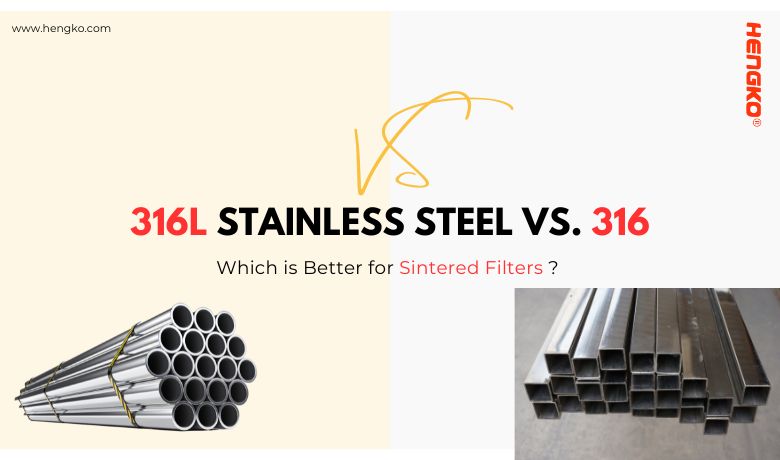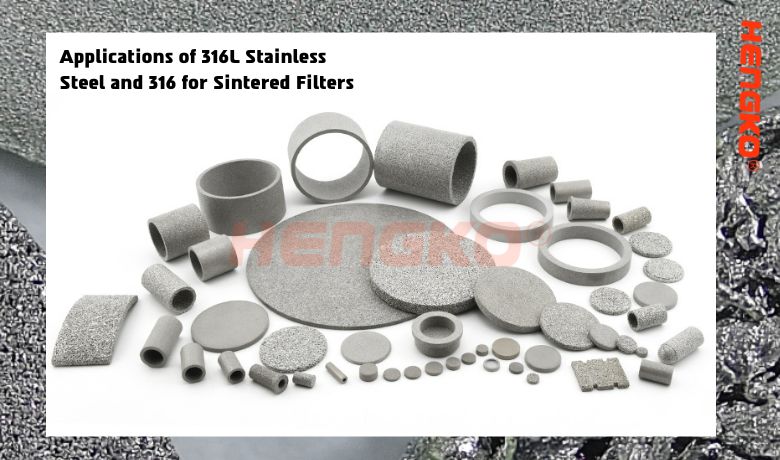316L Stainless Steel vs. 316: Which is Better for Sintered Filters?
When it comes to sintered filters, choosing the right material is crucial for ensuring optimal performance and durability. Two commonly used materials for sintered filters are 316L stainless steel and 316, both of which offer unique benefits and tradeoffs. In this post, we'll dive into the differences between these two materials and which one may be better suited for your specific application.
Overview of 316L Stainless Steel and 316
Before we get into the comparison, let's take a closer look at the composition of 316L stainless steel and 316. 316L stainless steel is a low-carbon variation of 316, containing around 17% chromium, 12% nickel, and 2.5% molybdenum. On the other hand, 316 contains slightly more carbon, around 16-18% chromium, 10-14% nickel, and 2-3% molybdenum. The slight variations in chemical composition between these two materials can affect their physical properties and suitability for certain applications.
Comparison of 316L Stainless Steel and 316 for Sintered Filters
1. Corrosion Resistance
One of the main differences between 316L and 316 for sintered filters is their corrosion resistance. Generally speaking, 316L is more corrosion-resistant than 316 due to its lower carbon content, making it a better choice for applications where the filter will be exposed to harsh or corrosive environments, such as marine or chemical processing industries.
2. Temperature Resistance
Temperature resistance is another factor to consider when choosing between 316L and 316 for sintered filters. Both materials can withstand high temperatures, but 316L has a slightly higher melting point than 316, making it more suitable for applications where the filter will be exposed to extremely high temperatures.
3. Strength and Durability
Strength and durability are also important considerations when choosing a material for sintered filters. 316L is generally considered to be stronger and more durable than 316, which makes it a better choice for high-pressure applications or applications where the filter will be subjected to significant wear and tear.
4. Purity and Cleanliness
Purity and cleanliness are also important factors to consider when choosing between 316L and 316 for sintered filters. 316L is typically considered to be a purer and cleaner material than 316, making it a better choice for applications where purity and cleanliness are critical, such as in the food or pharmaceutical industries.
5. Cost Considerations
Finally, cost is always a consideration when choosing a material for sintered filters. In general, 316L is slightly more expensive than 316 due to its superior properties and increased demand in certain industries.
Applications of 316L Stainless Steel and 316 for Sintered Filters
When it comes to applications, both 316L and 316 have their strengths and weaknesses. For example, 316L is commonly used in the marine, chemical, and pharmaceutical industries due to its superior corrosion resistance and purity, while 316 is often used in the oil and gas industry due to its high temperature resistance and strength.
A: 316L Stainless Steel Applications
1. Food and Beverage Industry:
316L is often used in food and beverage processing equipment due to its superior corrosion resistance, purity, and cleanliness. Sintered filters made from 316L stainless steel are commonly used in the filtration of beverages, such as beer, wine, and fruit juices.
2. Chemical Processing Industry:
316L is an excellent material for use in the chemical processing industry due to its resistance to corrosive chemicals and high temperatures. Sintered filters made from 316L stainless steel are often used in the filtration of acids, alkalis, and other corrosive chemicals.
3. Medical Industry:
316L is a biocompatible material that is often used in medical implants and instruments. Sintered filters made from 316L stainless steel are commonly used in medical applications, such as drug delivery systems and implantable medical devices.
B: 316 Stainless Steel Applications
1. Oil and Gas Industry:
316 is commonly used in the oil and gas industry due to its high temperature resistance, strength, and durability. Sintered filters made from 316 stainless steel are often used in the filtration of crude oil, natural gas, and other hydrocarbons.
2. Aerospace Industry:
316 is an excellent material for use in the aerospace industry due to its high strength and resistance to corrosion. Sintered filters made from 316 stainless steel are often used in aerospace applications, such as fuel and hydraulic systems.
3. Automotive Industry:
316 is also used in the automotive industry due to its high strength and resistance to corrosion. Sintered filters made from 316 stainless steel are commonly used in automotive applications, such as fuel filters and oil filters.
As you can see, both 316L stainless steel and 316 have a wide range of applications in various industries. Understanding the specific properties and applications of these materials can help you choose the right material for your sintered filter needs.
(FAQs) about 316L stainless steel and 316 for sintered filters:
1. What is the difference between 316L stainless steel and 316 for sintered filters?
316L stainless steel has lower carbon content than 316, which makes it more resistant to sensitization and corrosion. This makes it a better choice for use in applications where high levels of corrosion resistance are required, such as in the food and beverage or medical industries.
2. What are some common applications for 316L stainless steel sintered filters?
316L stainless steel sintered filters are commonly used in the food and beverage, chemical processing, and medical industries. They are also used in water filtration and for gas and liquid filtration in a variety of industrial applications.
3. What are some common applications for 316 stainless steel sintered filters?
316 stainless steel sintered filters are commonly used in the oil and gas, aerospace, and automotive industries. They are used for filtration of crude oil, natural gas, and other hydrocarbons, as well as fuel and hydraulic systems.
4. Can sintered filters made from 316L stainless steel or 316 be cleaned and reused?
Yes, sintered filters made from both 316L stainless steel and 316 can be cleaned and reused. However, it is important to follow the manufacturer's recommended cleaning and handling procedures to ensure that the filters are not damaged or compromised during cleaning.
5. Are sintered filters made from 316L stainless steel or 316 expensive?
The cost of sintered filters made from 316L stainless steel or 316 can vary depending on factors such as size, shape, and quantity. Generally speaking, 316L stainless steel sintered filters tend to be more expensive than 316 sintered filters due to their higher corrosion resistance and purity. However, the cost may be justified in applications where high levels of corrosion resistance are required.
6. What is the difference between 316L and 316 stainless steel?
316L stainless steel is a low carbon version of 316 stainless steel, which makes it more resistant to sensitization and intergranular corrosion. This makes it a popular choice for applications in which the material will be exposed to high temperatures or corrosive environments.
7. What are sintered filters made of?
Sintered filters are typically made of metal powders that are compressed and heated to create a solid, porous structure. The most common materials used for sintered filters include stainless steel, bronze, and nickel.
8. What is the pore size of a sintered filter?
The pore size of a sintered filter can vary depending on the application, but typical pore sizes range from a few microns to several hundred microns.
9. What are the advantages of using a sintered filter?
Sintered filters offer a number of advantages, including high strength, corrosion resistance, and the ability to withstand high temperatures and pressures. They are also highly effective at removing particulate matter from liquids and gases.
10. What are the disadvantages of using a sintered filter?
Sintered filters can be expensive compared to other types of filters, and they may not be suitable for applications in which very fine filtration is required.
11. What is the maximum temperature that a sintered filter can withstand?
The maximum temperature that a sintered filter can withstand depends on the material it is made of and the specific application. However, many sintered filters can withstand temperatures of up to 500°C.
12. Can sintered filters be cleaned and reused?
Yes, sintered filters can typically be cleaned and reused multiple times, which can make them more cost-effective in the long run.
13. What industries commonly use sintered filters?
Sintered filters are used in a wide range of industries, including pharmaceuticals, food and beverage, petrochemicals, and water treatment.
14. How do you select the right sintered filter for a particular application?
When selecting a sintered filter, it is important to consider factors such as pore size, material compatibility, and temperature and pressure requirements. Consulting with a filtration expert can help ensure that you choose the right filter for your application.
15. Are there any safety precautions that need to be taken when working with sintered filters?
Sintered filters can be sharp and may cause injury if mishandled. It is important to wear appropriate personal protective equipment, such as gloves and eye protection, when working with sintered filters.
So if you are Looking for reliable filtration solutions for your industrial applications? Contact us now to speak with our filtration experts and find the perfect sintered filter for your needs. Don't wait, improve your filtration process today!
Post time: Apr-06-2023






